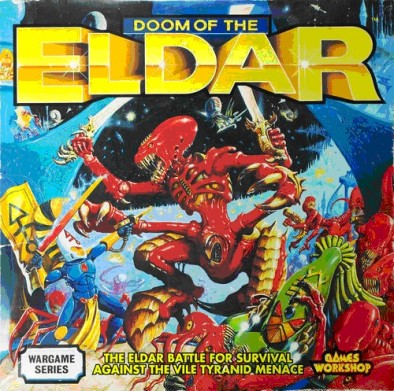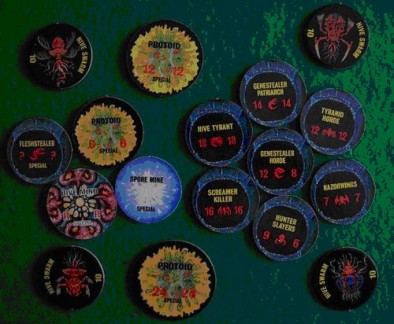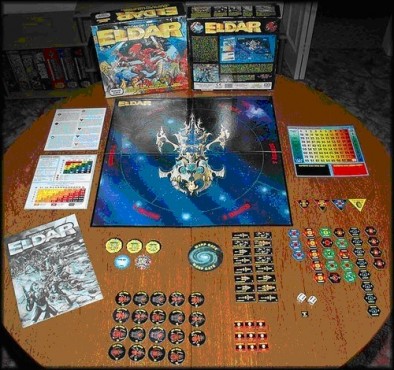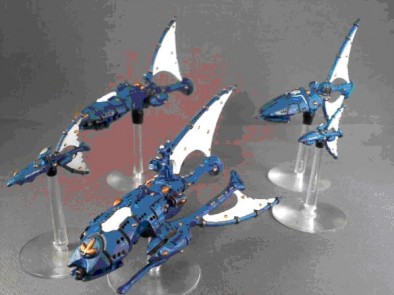From Empire To Fall: An Iyanden Intermission
June 25, 2013 by crew
Before we delve into the vast deeps of nostalgia that is second edition 40k let us take a moment to dwell on a little remembered piece of Eldar gaming history. The board game Doom of the Eldar. Doom of the Eldar was created by Jervis Johnson in 1993 with accompanying art by David Gallagher and Richard White. It is an important piece of Eldar history as it introduces one of the major events in Eldar background, the Siege of Iyanden.
The Craftworld of Iyanden found itself set on a course that would take it right into the path of a Tyranid Hive Fleet. Survival would depend on what fleet reserves it possessed and the strength and skill of its warriors. Escape was impossible and unthinkable. Should the Craftworld die then one of the last great bastions of Eldar civilisation would be lost to the galaxy.
Doom of the Eldar was a board game played with counters. No models were necessary to play and everything needed was inside the box. The board represented the Iyanden Craftworld which was huge and dominated the majority of the set up. Surrounding the Craftworld were a number of space sectors that the Hive Fleet would move through on their approach.
These Hive Ships would be intercepted by the meagre fleet assets that were available as a defence as well as the plasma missile batteries of the Craftworld itself. If the Tyranids did manage to breach these defences they would move across the sections of the Craftworld itself engaging the Eldar defenders. The Craftworld was detailed with palaces and hab domes and it was the Eldar player’s responsibility to prevent them from being spoilt by the foul xenos invasion.
At the time the Tyranids were still fairly ill-defined as a race though thanks to Space Hulk there were some units that had been added to the lonely Hunter Killer present in the Rogue Trader Warhammer 40K rulebook which would go on to become the humble Termagaunt. The two most prolific were Genestealers, protagonists of the main Space Hulk game, and Tyranid Warriors who had received plastic kits in Advanced Space Crusade. Added to this were the mysterious Hive Tyrants, the scythe armed Screamer Killers who were granddaddy to the Carnifex, and various squiggly beast swarms. Even Genestealer cult members found their way into the invasion fleet somehow managing not to be reabsorbed by the hive fleet.
Doom of the Eldar introduced Craftworld Iyanden. This was the first Craftworld to receive a proper amount of background. These Eldar’s main colours were yellow/blue or blue/yellow depending on which piece of art you were referring to. The blue and yellow Eldar were not Alaitoc who would not appear until much later in Eldar development. Though we know Iyanden for their Wraith armies now at this point the idea of Wraithguard and Wraithlords had not yet been refined properly. The events that would leave Iyanden a haunted wreck were being played out before us so the fall out of this disaster lay in the future.
Iyanden was used as an example of a standard Craftworld with access to Guardians, Seers, Aspect warriors and the Avatar of Khaine. Another surprising thing about the game was the lack of Imperial involvement. Not a human to be seen anywhere, not even a single solitary Space Marine!
Doom of the Eldar introduced Prince Yriel as a scion of Iyanden and the leader of the Eldritch Raiders corsair band. His story was linked to Iyanden’s predicament in a tale that has seen him elevated to special character status. The former high admiral of Iyanden’s fleet Yriel was exiled for allowing his pride to place Iyanden in peril. He became an outcast and formed the Eldritch Raiders, a corsair band that he led against the servants of Chaos. Upon hearing of Iyanden’s impending doom he and his fleet sped to their aid to lift the siege. Prince Yriel’s ship is one of the most powerful in the game and bears his distinctive deep blue with yellow tiger stripes heraldry.
Many years later a Battlefleet Gothic scenario would appear in Fanatic Magazine #19 with rules for Craftworld Eldar ships so that you could recreate the events of the board game in miniature form though given the size of a Craftworld not many were played near its hull, not that some people didn’t give it a try.
So from small beginnings lost to the mists of time and obsolescence did a piece of popular and enduring Eldar lore arise. With the release of Codex Iyanden this tale has been expanded even further but we will get to that in due course.
Lee Trayler
Read more from Lee on Conclave of Har.
BoW Ben - If anyone is interested in writing articles like Lee's for Beasts of War then please don't hesitate to contact me!
Supported by (Turn Off)
Supported by (Turn Off)
Supported by (Turn Off)















































































Any idea how much doom of the eldar retailed for when it was available?
I’m not entirely sure of it’s original pricing but nowadays on eBay I’ve seen it go from as low as £25/30 to as high as about £80.
There seems to be a fair few of them up there too!
BoW Ben
Blimey. 1993 is totally my era yet I do not remember Doom of the Eldar at all – possibly because there weren’t any figures in it 🙂
This series continues to amaze.
This was one of GW’s Hex Wargames, except this one didn’t have proper hexes and movement was treated differently from the other two (Horus Heresy and Battle for Armageddon). The unit counters are doublesided so tyranid fleet assets would convert to ground assets once they hit the craftworld. I feel really old now.
Wow, 20 years ago, I was the producer and graphic designer on the three board games, 😉
I wonder if FFG will ever reprint this one, as they reprinted Horus Heresy. I’d buy it if they did.
Still got my copy of this one – played it again last month and good fun it was too 🙂
I have this game Doom of the Eldar. but it should be named different :
Doom of the Tyranid
There is no way an Eldar player can lose this game.
O garish 1990’s GW box covers, I do not miss thee.